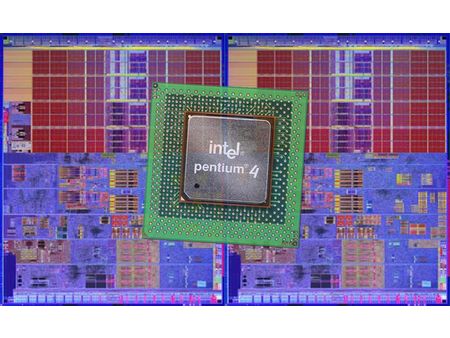Intel's 15 Most Unforgettable x86 CPUs
Pentium 4 Gets 64-bit And Another Core
In 2005, Intel improved its Pentium 4 twice. First, with the Prescott-2M, and then with Smithfield. The former was a 64-bit processor, based on the Prescott design, and the latter was a dual-core processor. They are fairly similar and have the same problems as other Pentium 4s: low instructions per cycle (IPC) throughput and difficulty in increasing the clock frequency due to current losses. These two processors, intended to limit losses while awaiting the Core 2 Duo, are not among Intel’s most highly regarded. And while the Pentium D (the commercial name of the Smithfield) does have two cores, in reality it’s an assembly of two Prescott dies in the same package.
| Code name | Prescott-2M | Smithfield |
| Date released | 2005 | 2005 |
| Architecture | 64 bits | 64 bits |
| Data bus | 64 bits | 64 bits |
| Address bus | 64 (actual 36) bits | 64 (actual 36) bits |
| Maximum memory | 64 GB | 64 GB |
| L1 cache | 16 KB + 12 Kµops | 2 x 16 KB + 12 Kµops |
| L2 cache | 2,048 KB | 2 x 1,024 KB |
| Clock frequency | 3–3.6 GHz | 2.8–3.2 GHz |
| FSB | 800 MHz | 800 MHz |
| SIMD | MMX, SSE, SSE2, SSE3 | MMX, SSE, SSE2, SSE3 |
| SMT/SMP | Hyper-Threading | dual cores (Hyper-Threading on certain models) |
| Fabrication process | 90 nm | 90 nm |
| Number of transistors | 169 million | 230 million |
| TDP | 84-115 W | 95-130 W |
| Voltage | 1.2 V | 1.2 V |
| Die surface area | 135 mm² | 206 mm² |
| Connector | LGA775 | LGA775 |
An interesting point is that whereas the Pentium 4 processors intended for the consumer market did not use the PAE technology (which enables 36-bit, as opposed to 32-bit memory management) and were therefore limited to 4 GB of RAM, these models can go beyond that limit. In practice, the address bus is still limited to 36 bits (40 bits on the Xeon), but PAE (management in 4 GB pages) is now ancient history—a 64-bit program is capable of making full use of the available memory.
Hyper-Threading, an Intel SMT technology, was available on certain models (Xeon and Extreme Edition). Finally, a 65 nm version (the 9x0 series) of the Pentium 4 was released later, but made no major improvements.
Get Tom's Hardware's best news and in-depth reviews, straight to your inbox.
Current page: Pentium 4 Gets 64-bit And Another Core
Prev Page Pentium M: Laptops Flex Their Muscles Next Page The First Mobile Dual-CoreTom's Hardware is the leading destination for hardcore computer enthusiasts. We cover everything from processors to 3D printers, single-board computers, SSDs and high-end gaming rigs, empowering readers to make the most of the tech they love, keep up on the latest developments and buy the right gear. Our staff has more than 100 years of combined experience covering news, solving tech problems and reviewing components and systems.
-
Arkz great article with only a few slight errors (like saying the core2duo has 1-4 cores... i don't think there's a 1 cored version lol)Reply
Looking forward to the AMD article. -
aleluja To correct you. Core 2 Duo has ONLY 2 cores, not more, not less.Reply
Core 2 Quad, has 4 cores and Core Solo has 1 core.
-
@ArkzReply
Yes there is a singal core,
http://en.wikipedia.org/wiki/List_of_Intel_Core_2_microprocessors#Single-Core_Mobile_processors
Ok it is not under the same branding but it is part of the same microarchitecture -
-Fran- I might be wrong, but i resemble that the Pentium 166 (32bits adress bus and all) had support for 4Gb of memory. I remember IBM sold it's top line (at that time) with 64Mb support (even with SDR PC100/66 support). Correct me if i'm wrong please.Reply -
neiroatopelcc The core 2 does supply 1-4 cores - 2 cores per die, where one might be disabled, and one or two dies on a socket. It's no less right to call a core2duo a cpu with 1-4 cores, than it is to put the pentium d on the same page as a single core prescot, as it's the very same principle.Reply -
cangelini Arkzgreat article with only a few slight errors (like saying the core2duo has 1-4 cores http://en.wikipedia.org/wiki/Coree ... i don't think there's a 1 cored version lol)Looking forward to the AMD article.Reply
Thanks for the heads-up! I tweaked that passage to better represent the Core 2 architecture's available configurations! -
randomizer vosesterOk it is not under the same branding but it is part of the same microarchitecture Exactly. The article says:Reply
ArticleThere are many versions of the architecture, resulting in configurations with a different number of cores
There is no mention of the branding, so there is no actual error there, just misinterpretation. -
ImSpartacus Arkzgreat article with only a few slight errors (like saying the core2duo has 1-4 cores... i don't think there's a 1 cored version lol)Looking forward to the AMD article.Reply
http://www.newegg.com/Product/Product.aspx?Item=N82E16819116039
Yes, it isn't called a "Core 2 Duo," but it uses the Core architecture and only has a single core enabled.
But I will have to say, there aren't any 3 core models... -
magicandy Good to hear you're not only doing an AMD article, but an ATI one as well (in response to the Nvidia article you did earlier, assuming). A sign of class from the new Tom's is a welcome one.Reply -
harrycat88 I wish they would get rid of those stupid SNAP Linkbubless and Inteltex misguiding links. Who ever invented those stupid annoying double lined text popups should have been burned at the stakeReply

